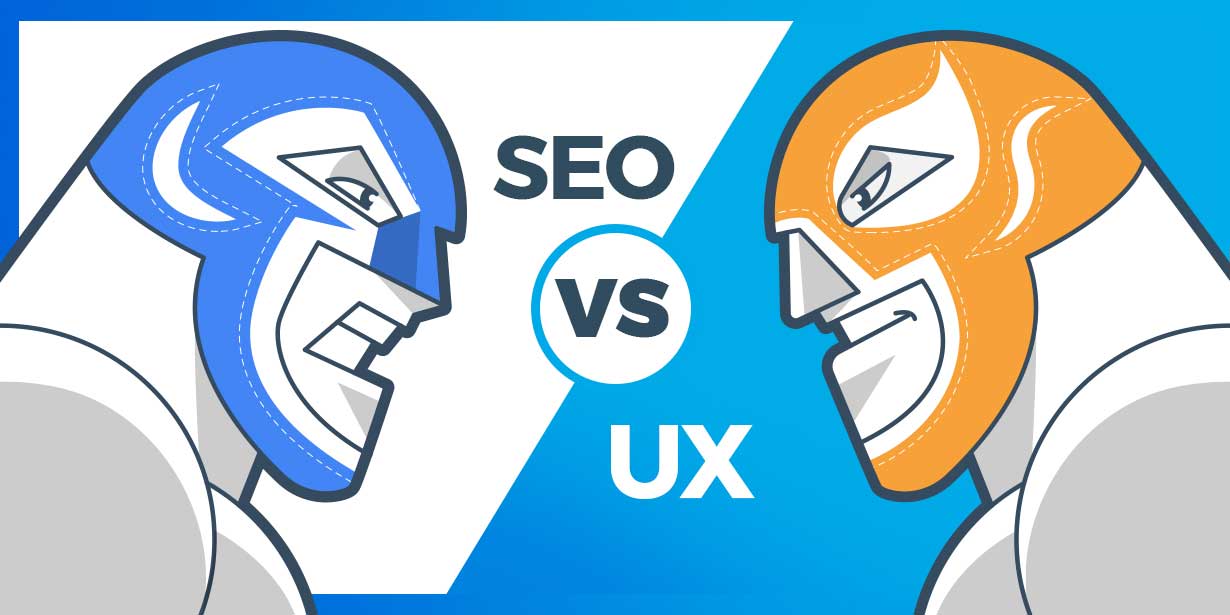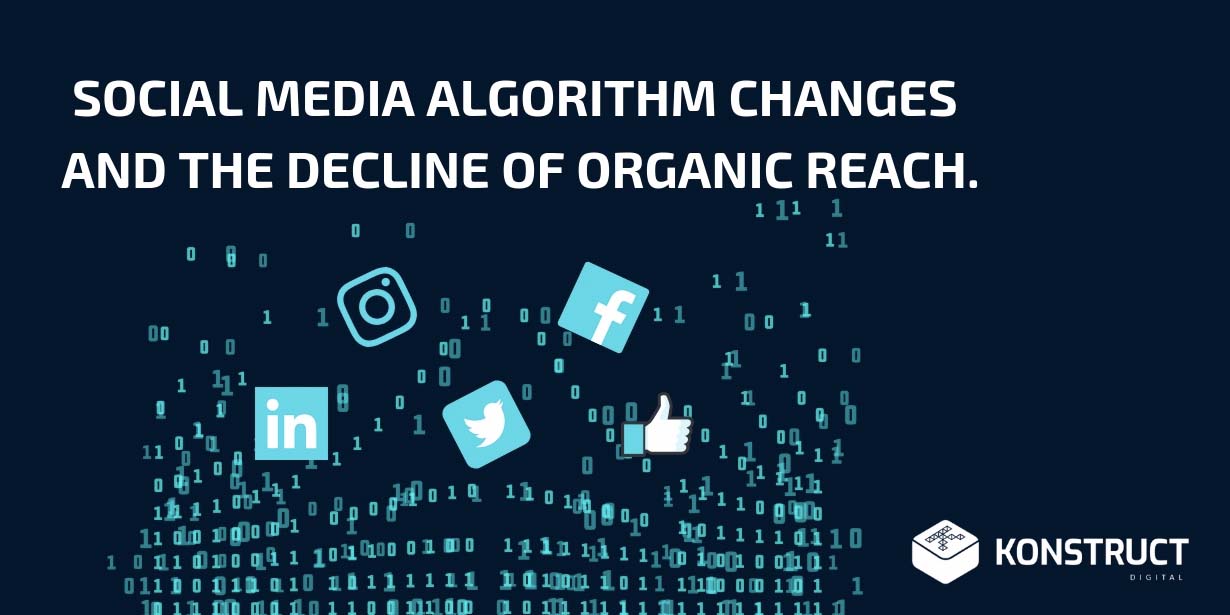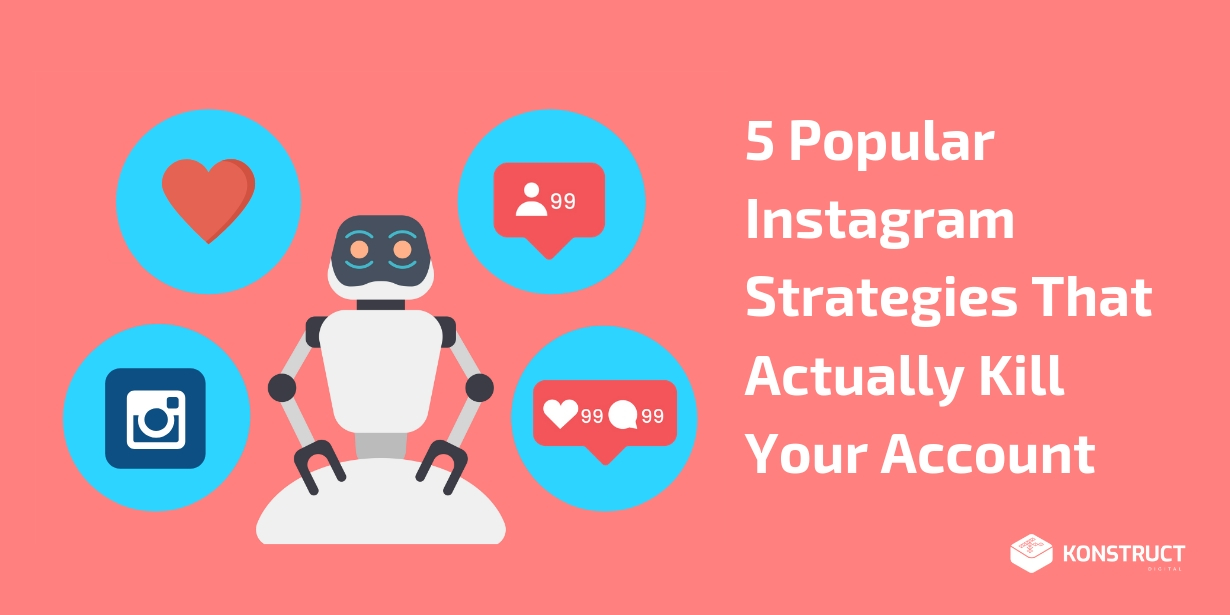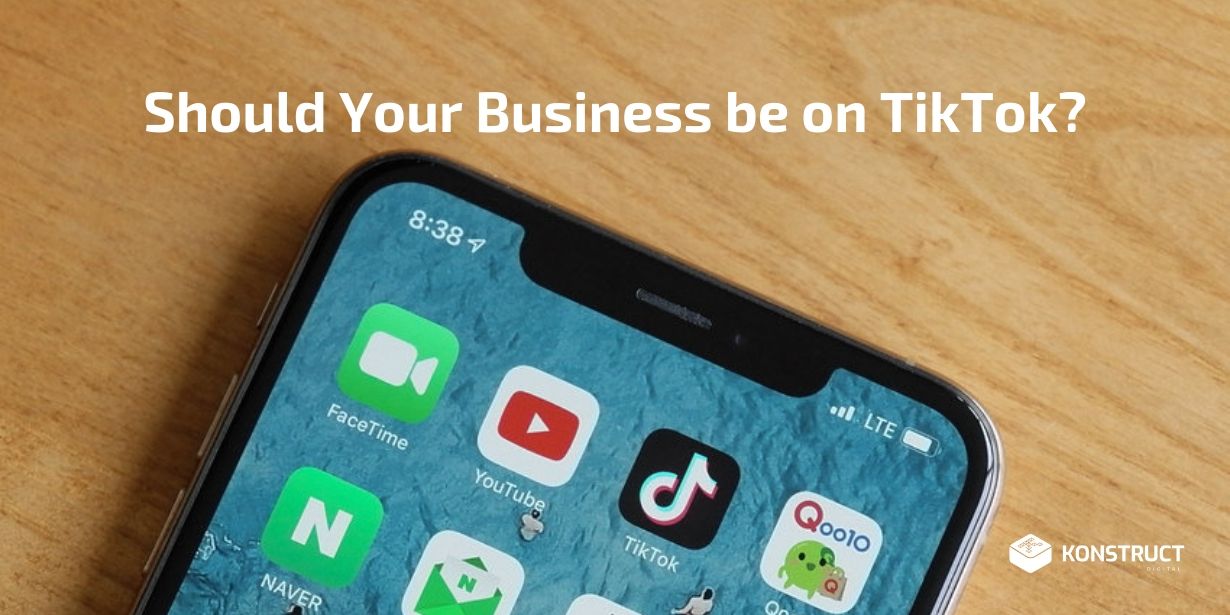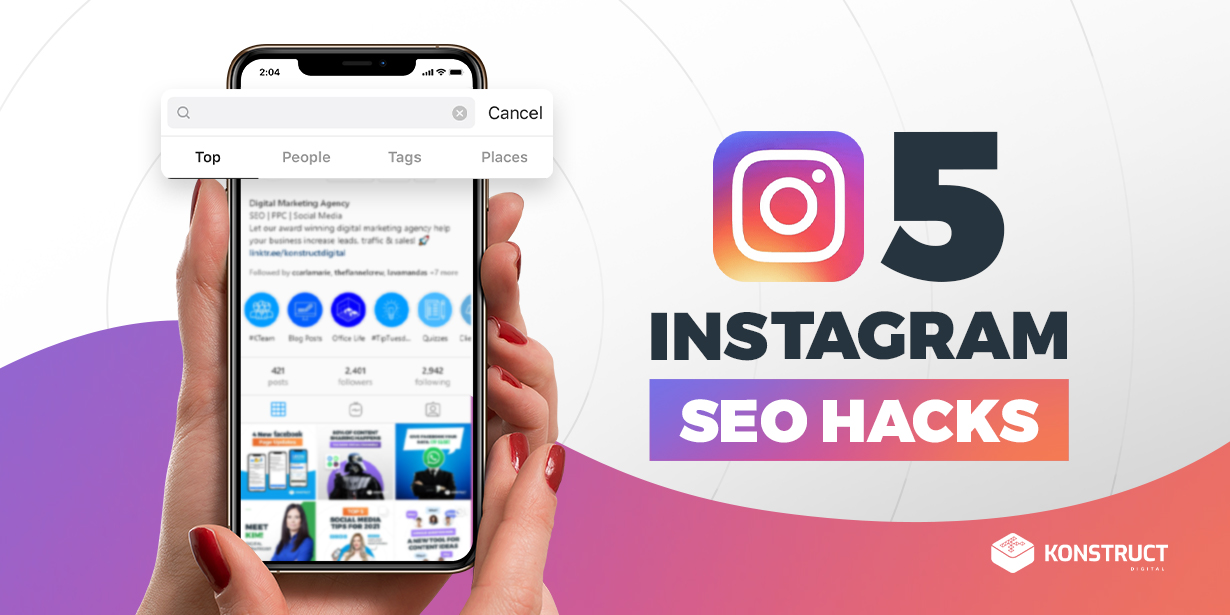What’s salt without pepper? Batman without Robin? A B2B business without a solid LinkedIn content strategy?
The answer: a futile mission.
Clearly, we’re advocates of LinkedIn, especially for B2B businesses. By strategically leveraging the LinkedIn platform, your B2B business can expand your reach and bring more prospects into your funnel while also continuing to nurture your audience throughout the buyer’s journey. So, why wouldn’t you take advantage of the platform?
The key though is doing it right… because many B2B businesses get it wrong.
And, getting your LinkedIn content wrong could mean wasting your time and resources on content that doesn’t drive any tangible results for your business, or worse—alienating your audience and turning your prospects away from your business and towards your competitors.
To do it right, you’ve got to start with a strategy.
But, where do you start? How do you make sure that you leverage the full potential of the LinkedIn platform to boost your brand’s credibility and dominate the conversation in the industry?
In this article, we’re going to give you insight into how you can transform your LinkedIn content strategy to widen your funnel, reach new qualified prospects, and establish your business as an industry leader, making your brand the first choice when it comes time for your prospects to make a purchasing decision.
Let’s dive in!
Why Content is Different on LinkedIn Than Other Social Media Platforms
Facebook originally started as a dating site, Instagram was first made for sharing photos with friends, Twitter was initially intended for sharing short messages with groups of people, but uniquely, LinkedIn was created for businesses and professionals.
Do you have an annoying friend or weird uncle that only talks about work at a family dinner or night on the town? That’s what it’s like when B2B businesses try to show up in places where they don’t belong. On the other hand, LinkedIn is like a business lunch where everyone is on the same terms.
Basically, LinkedIn is often the best social media platform to reach key decision-makers in your B2B industry in the context where they are most likely to welcome and appreciate content from your brand.
Founded in 2002, LinkedIn saw 13 million active users by 2007 and 66.8 million active professionals by 2022. In its 20 years of existence, LinkedIn has proven to be a great platform for B2B businesses. See these stats for proof:
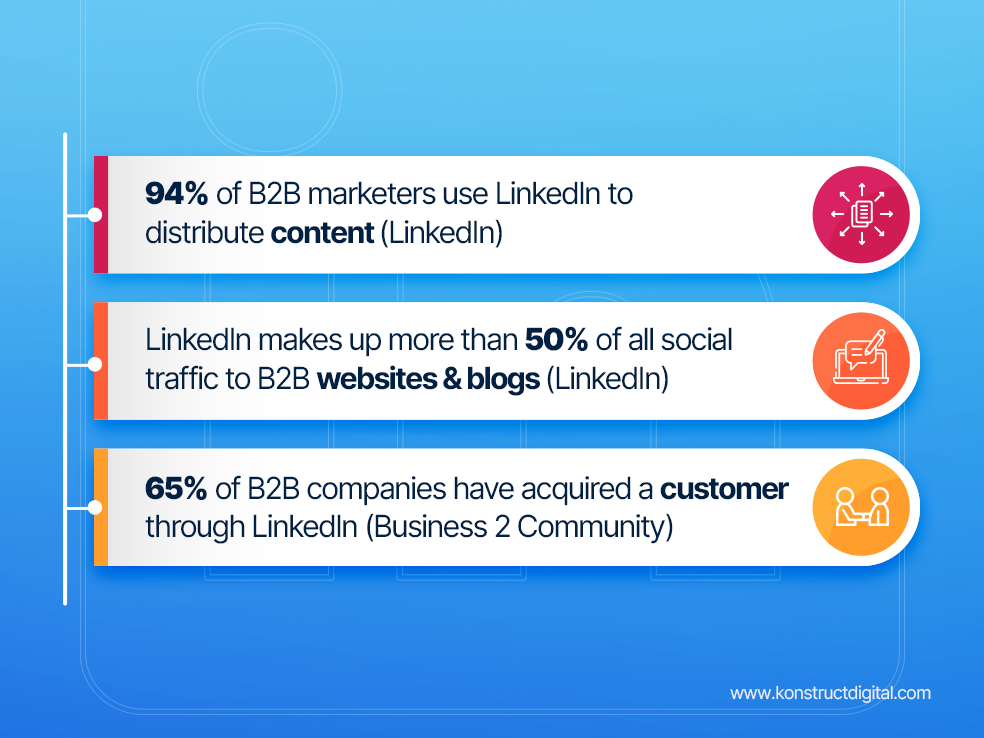
How to Create a Winning Content Marketing Strategy for LinkedIn
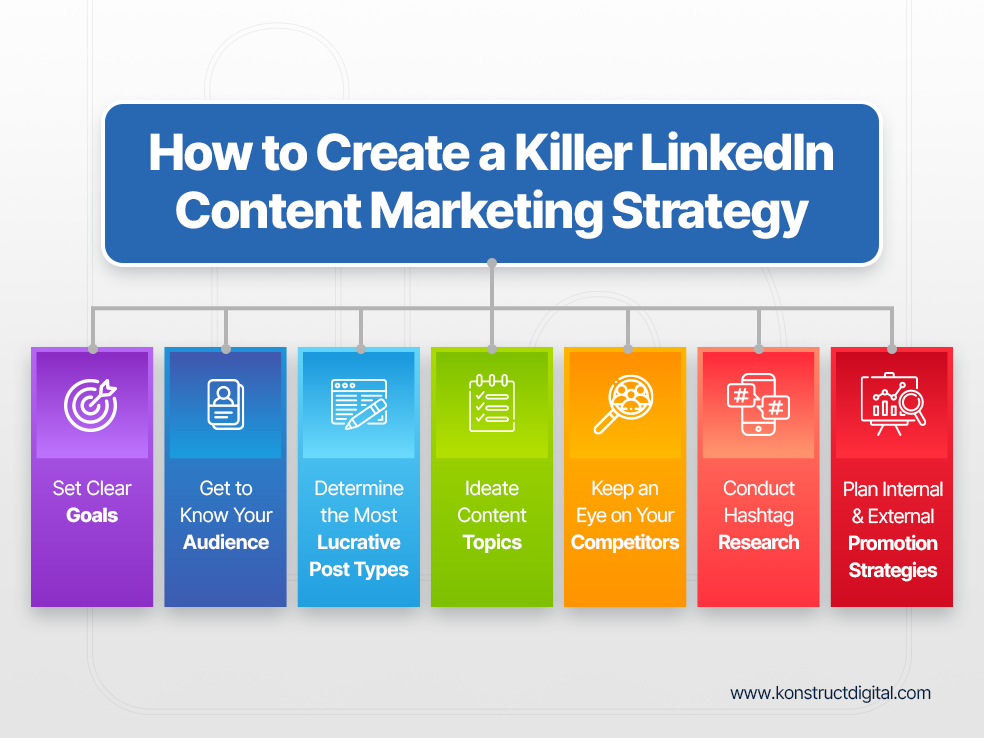
When it comes to posting content on social media sites, many B2B businesses tend to downplay the importance of creating a solid LinkedIn content strategy. LinkedIn posts shouldn’t be just random thoughts that marketing managers throw together at the last minute.
To maximize your return on investment (ROI) and ensure that your posts actually have a positive impact on your business, you need to create a LinkedIn content strategy. Usain Bolt didn’t wake up one day and win a gold medal at the Olympics. He spent his entire life training and strategizing for his big win–and you will too (maybe not your entire life, but you get the gist).
With years of experience helping B2B businesses jumpstart their LinkedIn marketing strategy, we’ve developed a proven formula that helps B2B businesses succeed on the platform.
Below, we give you insight into some of the key elements that we include when developing a LinkedIn content marketing strategy for our B2B clients and we welcome you to steal this formula for your own LinkedIn marketing efforts!
Set & Understand Your Goals
Before you dive into deciding what you’re going to post and your posting schedule, you need to ensure that you formulate and document your LinkedIn goals. Setting goals will help you track and measure the success of your strategy and help you determine if you need to adjust your content to meet your goals later down the line.
Before you say “I want to use LinkedIn to increase my volume of leads and sales,” it’s important to take a step back and consider the value of the LinkedIn platform for B2B businesses.
As you probably know, B2B businesses often have longer sales cycles than businesses that sell to consumers. This is due to the fact that B2B products and services are typically a significant investment often requiring significant research and buy-in from multiple different stakeholders and executives.
That means that for B2B businesses, the likelihood of a customer stumbling across your post and immediately filling out a contact form is very slim—no matter how persuasive your copy may be.
LinkedIn functions much more effectively as a tool to widen your net and build a community. It allows you to extend your current reach to make your brand visible to new potential customers or clients while giving you the opportunity to build your authority with your target audience and ensure that your brand remains top of mind when your prospects are finally ready to make a purchase.
When you truly understand the value of LinkedIn for your business, you can begin to create SMART goals for your LinkedIn marketing efforts— That is, goals that are specific, measurable, achievable, relevant, and time-based.
For example, if your primary goal is to widen the net of your B2B brand, reach and followers will be important metrics to track.
If you want to use LinkedIn as a tool to nurture your existing prospects and build stronger credibility and relationships with your audience, likes and comments will help you assess the performance of your LinkedIn content.
Get to Know Your Audience
If you already have an existing LinkedIn presence, it’s high time you look into who is following your brand. Does it align with your buyer personas? Or is your current LinkedIn content attracting people who are unqualified or unlikely ever to convert?
Here’s how to take a deep dive into your LinkedIn followers:
- Head over to LinkedIn and go to your profile
- Click “Analytics” at the top of the page
- Click “Followers” from the drop-down menu
- Scroll down to “Follower Demographics”
- Go through all the sections from the drop-down menu (job function, company size, industry, location, seniority)
So, who’s following you? If your followers are right in line with the key decision-makers in your industry that you want to be targeting, then great! You’ll know that you’re already doing something right by reaching and attracting the right people.
But, what if your followers aren’t in line with your target audience? Well, then you’ve got some work to do. This could be a sign that you need to invest some more time in understanding the needs and pain points of your ideal buyers.
One of the best ways to do this is to talk to your sales team. They have first-hand experience talking to your prospects and buyers about their problems and explaining why your business is the solution they need.
If you don’t already have well-documented buyer personas that identify their demographics, frustrations and the value propositions that are most compelling to each type of buyer, there’s no time like the present to get those nailed down.
Keep an Eye on Your Competitors
Now it’s time to bring out your inner Sherlock Holmes and do a deep dive into how your competitors are leveraging the LinkedIn platform. If you find your competitors are crushing it on LinkedIn, you should probably draw some inspiration from their content strategy. Or maybe your competitors are really falling short… In that case, what are they doing that’s failing or what are the gaps they’re leaving wide open that you can fill?
Here’s how we suggest you keep an eye on your competitors:
- Go on LinkedIn and search for companies that are similar to yours.
You may already have a keen awareness of the competitors in your industry. In that case, this step should be pretty simple. If not, you’ll need to do some more digging. You can also leverage the LinkedIn search function to search for keywords or hashtags relevant to your business to see what accounts LinkedIn pulls. Keep in mind that you don’t just need to find direct competitors in your industry. You could also look at similar companies targeting different geographical areas or companies in a slightly different but related market space to draw inspiration for your strategy.
- Create a spreadsheet of competitors/ inspiration feeds.
Keep note of all of the accounts you find that are either inspiring or direct competitors to your business so that you can assess and compare their LinkedIn content to your own and each other.
- Identify competitor strengths and weaknesses.
Make note of the things that each account is doing well (whether it’s something you like or something that is receiving good engagement) and the things that aren’t working that you’ll want to avoid when creating your own content.
Important note: If you’re a B2B business in a niche industry, chances are your competitors haven’t invested a lot of time into social media marketing. In that case, you can look beyond your direct competitors and look into related industries. Oftentimes, by expanding your horizons, you can find more inspiration.
Determine the Most Lucrative Post Types for Your Business
Below we’ve outlined some different post types you may want to rotate in your B2B social strategy.
- Articles. LinkedIn posts have a 1,300-character limit, whereas LinkedIn articles have a 125,000-character limit. If you want to share some long-form content with your users, definitely create a LinkedIn article. Additionally, these post types generate 3x more clicks than any other content type!
- Still Images. Visuals are everything! Did you know posts with images typically result in a 2x higher comment rate? Don’t stop using visuals in your posts.
- Native Video. LinkedIn members are 20x more likely to share a video on LinkedIn than any other post type. If that doesn’t convince you to post more video content, we aren’t sure what will!
- Documents. Share hiring posts, company culture stories, tradeshow event promotions and more with LinkedIn documents.
Once you’ve experimented with different post types, invest more time into the post types with the highest reach and engagement and less time into the post types that constantly fall flat.
Ideate Content Topics
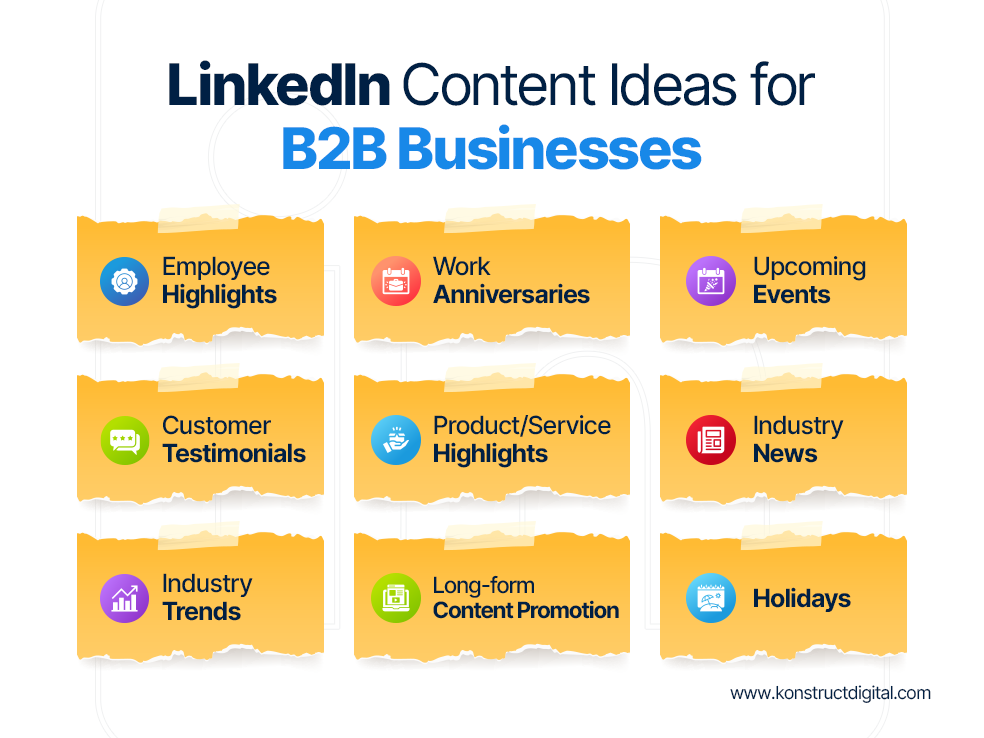
One hard truth that many B2B businesses fail to understand is that most LinkedIn users are turned away from businesses that only use LinkedIn to promote their products or services.
Very few people want to waste their precious free time reading social media posts that are purely self-promotional. B2B buyers want to consume valuable content that provides useful and relevant insights or will help them get ahead in their careers.
Ideating a list of content topics ahead of time will help you ensure that you have a selection of valuable content ideas to pull from when it comes time to create your content.
If you’ve been posting on LinkedIn for a while, it’s also a good idea to determine the most successful posts you’ve published in the past so you know what kind of content your audience enjoys. One easy way to determine top-performing posts is to look at your LinkedIn analytics.
Here’s a quick step-by-step on how you look at your analytics on LinkedIn:
- Go to your LinkedIn profile
- Click “Analytics” in the top left corner
- Click “Updates” from the drop-down menu
- Browse through your metrics and see what’s working and what isn’t working
If you need some new inspiration, here are some solid content topic ideas you’ll probably want to steal:
Company Posts
Highlight any exciting company updates or announcements. Here are some company update examples:
- Feature your new employees and elaborate on the experience and expertise that they are bringing to your company.
- Share job postings to encourage people to apply and show that your company is growing.
- Celebrate work anniversaries to demonstrate to your audience that you value your employees.
- Promote upcoming tradeshows or other events to increase registration and encourage attendees to visit your representatives at the event.
- Share your company values to help your audience relate to your business.
Customer Testimonials
Customer testimonials are a fantastic source of social proof for your business. You can create a graphic that includes a quote from a recent review that you received, or better yet— take a video of one of your clients or customers sharing how your business was able to solve their challenges (if the resources are available).
Products/Services
So… we know we said that you shouldn’t just use LinkedIn to promote your products or services but it’s not a bad idea to sprinkle these posts into your calendar sparingly.
When writing these posts, a good rule of thumb is to focus on your customer’s pain points for the first half of the caption and only talk about your business for the last half of the caption. Otherwise, you risk users reading the first line of the caption and immediately scrolling past your post.
Industry News & Trends
Discuss what’s going on in your industry and provide unique and valuable insights on trending topics. This not only provides value to your audience and encourages more users to follow your business for more, but it also proves that your business is at the leading edge of your industry.
Our favourite place to keep up with industry news is Google News. You can set up relevant saved searches to make it easier to scan relevant news stories.
Long-Form Content Promotion
Producing long-form content like blog posts, case studies or whitepapers is a significant investment, so don’t let your efforts go to waste! Promoting long-form content will give you the opportunity to get more eyes on your content to maximize ROI.
At the same time, your long-form content should be relevant and interesting to your target audience (as long as you’re doing it right!) If your long-form content is valuable to your followers and something that they want to read, you’ll ultimately increase your brand’s credibility by sharing it.
Holidays
Nowadays, there’s a new holiday for practically everything and that includes holidays related to B2B businesses. For example, in the cloud computing industry alone, relevant holidays include National Technology Day, Data Privacy Day, Programmer’s Day, Cyber Security Awareness Month, and much more. Celebrating these holidays gives you a great opportunity to talk about topics relevant to your business and add your own unique insights to demonstrate your expertise.
Hashtag Research
If your LinkedIn post is a milkshake, hashtags are the cherry on top. Each hashtag on LinkedIn is indexed by the LinkedIn search feature and has a dedicated content explore page where users can find the most popular and relevant content that uses each specific hashtag.
Additionally, many users follow hashtags in their niches, meaning that posts with hashtags can show up in their regular feeds, even if the user doesn’t follow you.
LinkedIn hashtags help you target potential customers that have already shown interest in your hashtagged topic. By using hashtags, you can expand your reach and expose your brand to people in your target audience that are currently beyond your reach–making them a good lead-generation tool.
Creating a couple of hashtag groups that are relevant to your different product/service offerings is a great idea to save time down the line. Within these groups, you should have between 5-10 hashtags that you can repurpose every time you talk about each specific topic.
Here are some best practices for choosing hashtags:
- If your business is a local business, prioritize using local hashtags when possible.
- Avoid hashtags that are overly broad and could relate to many different things (ie. #success, #business).
- Find hashtags that are relevant to the specific topics you commonly talk about.
- Aim for a mix of more niche and more popular hashtags.
Now that you have an idea of what hashtags you’re looking for, it’s time to start the hashtag hunt. Let’s say you’re writing a post about digital marketing news; here’s how you’ll find relevant hashtags:
1. Start with a generic word/phrase
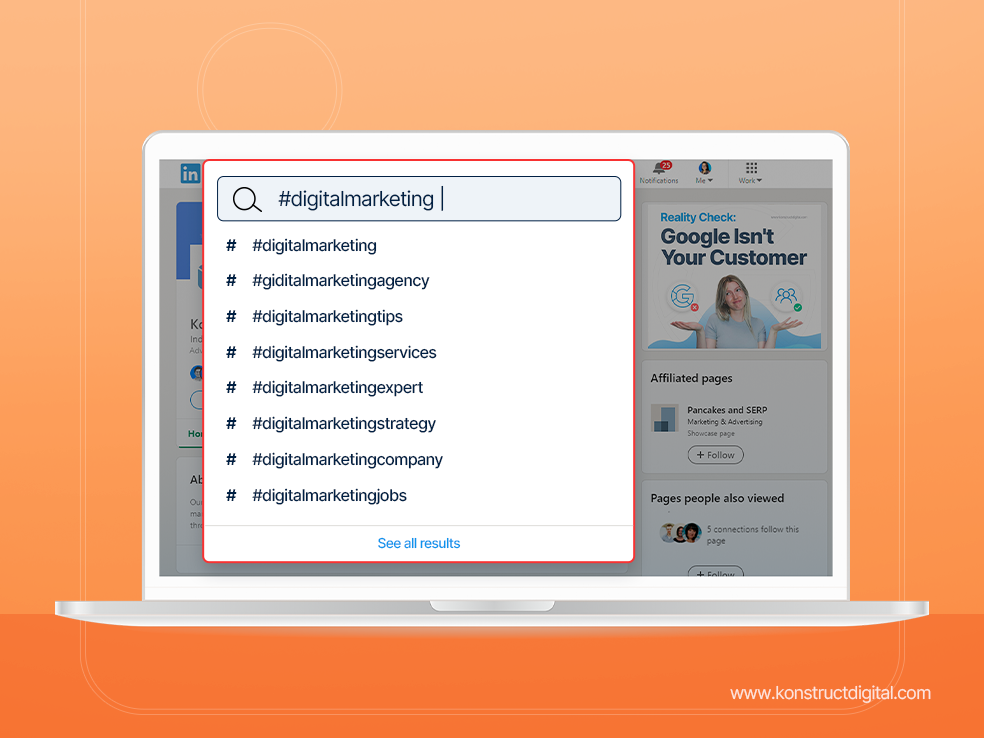
2. Click on a hashtag that is relevant to your content

Once you click on a hashtag, the hashtag page will appear. As you can see, #digitalmarketing has over 25 million followers. If you choose to include a hashtag like this in your hashtag groups, aim to balance it out with more niche hashtags with 1K to 10K followers.
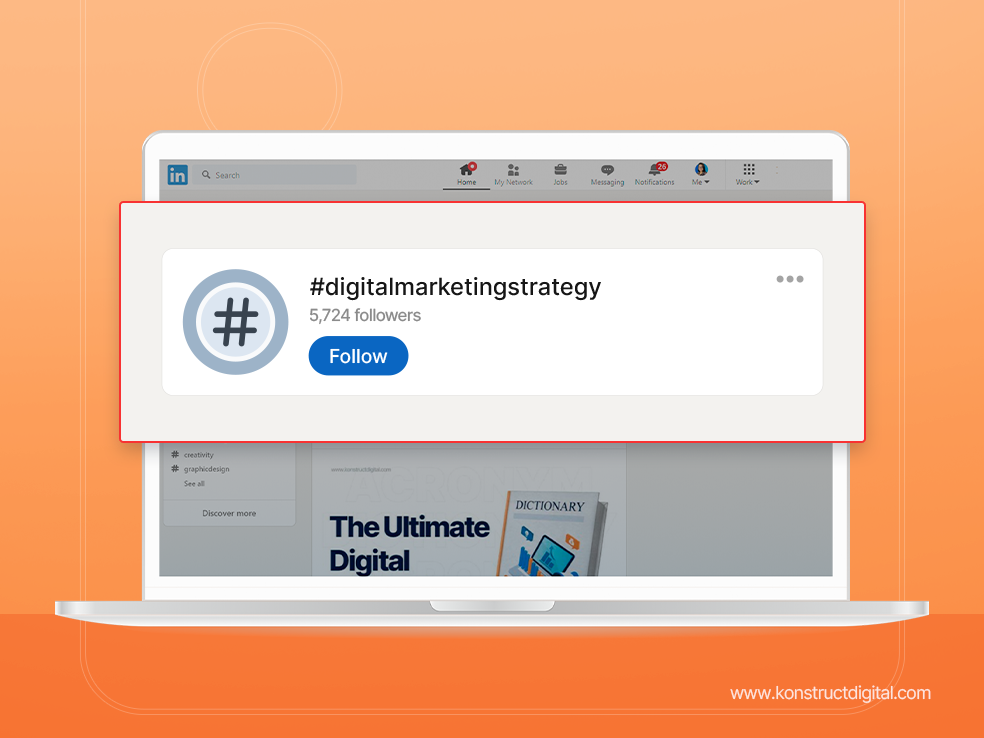
We searched “#digitalmarketing” again, but this time chose #digitalmarketingstrategy with just over 5,000 followers.
3. Avoid hashtags with no followers
Sometimes you’ll search for a hashtag and there won’t be a corresponding hashtag page. In this case, it’s best to skip this hashtag as it likely has little to no followers.
An exception to this rule is any branded hashtags such as hashtags for conferences that your business is attending. In this case, there is still value in using these hashtags, even though the hashtag may not have many followers.
4. Repeat these steps and generate as many relevant hashtags as possible
Source as many quality hashtags as you can that are relevant to your business so that you have a variety of hashtags to choose from when it comes time to draft your social media content.
Internal Promotion
One content strategy that you may want to consider is internal promotion. Internal promotion is the act of training your staff to engage and share your content on LinkedIn, which can increase the reach of your content.
When your LinkedIn posts receive immediate engagement after being published, LinkedIn will typically reward you with greater reach. Ultimately, LinkedIn wants to show users the best content to keep them on the platform. Posts that receive a lot of immediate engagement are assumed to be quality content, so LinkedIn is more likely to share these posts on more users’ feeds.
To learn more about internal promotion, read our blog post, 9 Unique Ways to Fix Your Employee Social Media Engagement. We discuss all the juicy info on why employee engagement is crucial and how to motivate your employees to level up their engagement.
External Promotion
Our final point in the article is external promotion. Before we get into it, give yourself a pat on the back for reading all of this and taking the time to learn A LOT about creating a LinkedIn content strategy. Now back to your regularly scheduled programming…
External promotion on LinkedIn involves promoting your business or content to people outside of your current reach via boosted posts. Boosting posts is an efficient way to increase your reach and widen your funnel, bringing more prospects to your business, if you have the budget for it.
Make Your Brand Rise Above the Rest With a Solid LinkedIn Content Strategy
Social media can feel like a very time-consuming task for a marketing manager with many other priorities to juggle. It’s also no simple feat trying to stay on top of the constantly changing LinkedIn updates and features.
If you’re looking for support with your LinkedIn content marketing, our content team could be your saving grace.
Our content specialists are wordsmiths who are skilled in capturing the brand identity of B2B brands, helping to expand brand reach, improve credibility and authority and establish brands as thought leaders in their industries.
Not only do we know the ins and outs of social media, but we also take pride in understanding your audience and their needs and the complexities of your industry or market.
Let’s work together to create a LinkedIn content strategy that will help your business attract and engage today’s B2B buyers. Contact us today!



